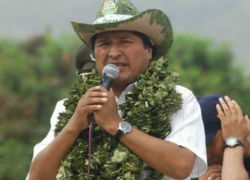With new data showing Bolivia coca cultivation has reached its lowest point in over a decade, InSight Crime spoke with a leading expert on how the Andean nation’s innovative coca policy has lowered potential cocaine production while fostering greater respect for human rights.
Last year, coca cultivation in Bolivia fell to its lowest levels since 2002, according to a new report (pdf) by the United Nations Office on Drugs and Crime (UNODC). This is the fourth consecutive year of declining coca crops, and the 20,400 hectares cultivated in 2014 is a 34 percent decrease from a high of 31,000 hectares in 2010.
In anticipation of the release of these figures, InSight Crime sat down with Kathryn Ledebur, Director of the Andean Information Network (AIN) and co-author of the recent report, “Habeas Coca: Bolivia’s Community Coca Control.” Ledebur discussed the achievements and challenges facing Bolivia’s coca-growing industry, and how its impacted drug trafficking and organized crime across the region.
What You’ll Find Out
2:30: You’ll find out what a cato is, and how it regulates coca growing in Bolivia.
5:15: “Bureaucracy is irritating, but forced eradication and militarization is life-threatening.”
12:15: You’ll find out why coca growers in Bolivia have next to no financial incentive to sell their product on the black market.
14:00: “The advantage in Bolivia is that you don’t have a group like the FARC [in Colombia] or the Sendero Luminoso [in Peru] engaged in coca growing regions.”
20:30: “Interdiction… is only the ability to affect or shift the drug trade, but drug interdiction will never end the drug trade.”
24:00: You’ll find out which special Coca Cola ingredient doubles as a “narcotic” listed under the same UN category as heroin and cocaine. (You can probably guess.)
29:15: “I don’t think there is a feeling that the DEA has been sorely missed.”
*This is the first installment in the InSight Crime podcast series, a pilot initiative that seeks to provide our audience with new ways to explore issues related to security and organized crime in Latin America. We hope you enjoy listening.
*The UNODC figures for coca cultivation in Colombia are signficantly different from the White House estimates Ledebur referred to in the podcast. The UNODC estimated there were 69,000 hectares of coca grown last year in Colombia.

